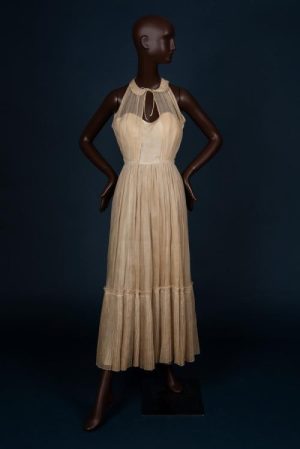Isaac Newton’s prism did not initially spotlight white and it wasn’t until the 19th century that white became prominent in fashion, most notably being formalized as the color choice for wedding dresses. Nevertheless, at Southern Methodist University, white dresses have come to symbolize a tradition of closing one chapter and eagerly anticipating the next.
“I’ve never considered not wearing white for graduation because I’ve seen girls wear white since I came to SMU,” says Abby Carter, who graduated from SMU in December. “It just seemed like a formality.”
SMU students like Carter carry the tradition of dressing in white at graduation to honor their time spent at the university.
Although it’s difficult to pinpoint exactly when white dresses became traditional SMU garb, photos in the university archive highlight the practice in 1919. Fashion historians say other private universities and high schools share the tradition; the Seven Sisters colleges (Barnard, Bryn Mawr, Mount Holyoke, Radcliffe, Smith, Vassar, and Wellesley) developed traditions in the late 19th century and continue to follow them today while local high school, The Hockaday School, follows a similar tradition for high school grads.
Yet, the color white has a long history of symbolism attached to it. The color rose to prominence in women’s fashion during the Victorian era, according to Carmela Spinelli, a fashion historian and recruitment specialist at the Savannah College of Art Design. “White dresses were put on the map after Queen Victoria wore one at her wedding to Prince Albert in 1840,” Spinelli says.
Before Queen Victoria, women suffragettes in both the U.S. and the U.K. donned white when advocating the right to vote, and white dresses symbolized major milestones in Euro-American Judeo-Christian traditions dating back to the late 19th century.
Yet, the color white also has a racial symbolism as well, says Annette Becker, director of the Texas Fashion Collection at the University of North Texas. Throughout the 18th and 19th centuries, women wore white undergarments to show the cleanliness of those garments often tied to ideas about race and whiteness. “The whiter the undergarment was, the whiter you were as a person,” Becker explains.
“White is often associated with high statutes, like high-quality Flemish linens, which were the hottest commodities you could possibly find. The whiter and finer the fabric, the more desirable it was.”
Since then, white has taken on many different connotations including luxury, wealth, purity, and rebirth. In the 1960s, white increasingly became a statement during the Light and Space Movement, Spinelli says. Metal, silver, white, and modern elements dominated this era, discovering a whole new palette for the fashion industry.
When thinking about the role of white today in fashion, Becker emphasizes that white resembles not just a color but something larger, urging individuals to respect rituals rooted in history. “We get to live our life on a foundation built by other people and having a sense of generosity and thinking about that deeply is important too,” Becker says. “Meaning is imbued on traditions when people engage with them thoughtfully.”
SMU seniors say they are eager to carry on this Mustang tradition.
“I absolutely love the idea of wearing white dresses,” Katrina Anderson says. “It honors the significance and importance of graduation, and I wouldn’t want it any other way.”
Lucca Scibird agrees. “I love being a Mustang and I’m very proud of SMU,” Scibird says. “Wearing white to graduation is something I’m undoubtedly participating in because it’s been a tradition for so long.”
Meaghan Doherty appreciates how wearing white to graduation unifies the current graduates creating a community and at the same time is the ultimate nod to the diverse group of graduates that have come before her. “No matter who they are friends with, what organization they are in, or where they are from, everyone unites together and wears the same uniform or color of clothing,” Doherty says.
Fashion historian Becker points out that sticking to the tradition of wearing white on graduation might seem like an antiquated practice, but it allows people to keep the connection to traditions and history alive.
Those who wore white to graduations, such as SMU junior and Hockaday graduate Alex Rabin, agree. At the Hockaday School, seniors wear matching white dresses to graduation; the school collectively votes on one dress in September and each grad wears it at graduation.
“I love the tradition where the whole grade wears the same dress to graduation,” Rabin says. “It symbolizes a culmination of our experiences together at an all-girls school where we spend so much time together.”
Meanwhile, when 2023 SMU graduate and Dallas-based influencer Alexa Field graduated, she also participated in the tradition.
“I truly never thought about not wearing white to graduation,” Field says. “Unifying in white attire encourages graduates to be thoughtful about the weekend and adds an elegant touch to the celebration.
Taking the time to celebrate what you’ve accomplished over the past few years and dressing up in a cohesive manner is something special to SMU.”
And, Field says she saw signs of change amongst her graduating class; namely, jumpsuits, rompers, and pantsuits — in white, of course. “People can find creativity and push the boundaries,” Field says, “but…white is a non-negotiable for those events.”
This story was reported and edited as part of an SMU Fashion Journalism Spring 2024 class.










